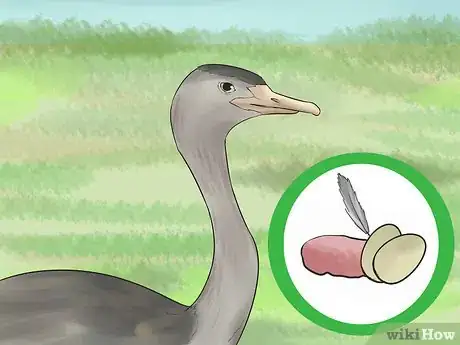This article was co-authored by Deanne Pawlisch, CVT, MA. Deanne Pawlisch is a Certified Veterinary Technician, who does corporate training for veterinary practices and has taught at the NAVTA-approved Veterinary Assistant Program at the Harper College in Illinois and in 2011 was elected to the board of the Veterinary Emergency and Critical Care Foundation. Deanne has been a Board Member of the Veterinary Emergency and Critical Care Foundation in San Antonio, Texas since 2011. She holds a BS in Anthropology from Loyola University and an MA in Anthropology from Northern Illinois University.
There are 9 references cited in this article, which can be found at the bottom of the page.
This article has been viewed 45,395 times.
If you have decided you would like to try your hand at raising the South African rhea, a relative of the ostrich, you'll need lots of space and proper shelter. You will also need some knowledge about feeding and caring for rheas properly. You can raise the rhea to help increase its population or to produce rhea oil and cream. Either way, if you want to raise happy and healthy rheas, you’ll need to be informed about their needs and work hard to care for them properly.[1]
Steps
Deciding to Raise Rheas
-
1Consider your reasons for raising rheas before purchasing them. No matter why you are raising rheas, you must be dedicated to taking care of them and facilitating their healthy growth. However, some of the most common reasons for raising rheas include:[2]
- Meat.
- Feathers and leather.
- Oils and creams.
- Eggs.
- Selling chicks to other rhea raisers.
- Furthering their protection.
- For their own sake.
-
2Check whether you'll need a permit in your state, province, region or country. In some places, the fact that rheas can be treated as livestock means that you may not need to get any special license or permit. However, this will vary depending on your location, so always check first.
- You may also need permits if you are planning on selling rhea products, such as their meat.[3]
Advertisement -
3Select your rhea stock. There are two types of rhea, the white rhea and the common or gray rhea. Unless you need the particular color, both types should be fine for raising. In order to find a reputable breeder, you should ask as many questions as possible about the health, background and care requirements for the birds you choose.[4]
- Ask a potential breeder a variety of questions, such as, "What is the health history of your breeding birds?", "How often do you feed your birds?", "What do you feed your birds?", "Are your birds free of genetic problems?", and "How did you get involved in rhea breeding in the first place?"
- Look at a potential bird for signs of illness or deformity, as you don't want to get a sick bird. Make sure that the rhea's feathers are all intact, that there are not bald spots on the bird, and that the bird doesn't have any symptoms of illness, such as signs of diarrhea and lesions or seeping on the face, neck, or ears.[5]
- It is a really good idea to get an experienced rhea breeder to accompany you when purchasing your first rhea chicks or adults. This person will know to ask the right questions and will know how to steer clear of inbred, deformed or unhealthy birds.
Housing Rheas
-
1Keep newborn rhea warm. Use a dog house or kennel to house hatchling rheas and keep them out of the elements. Make sure that the floor is easy to clean so that you can protect the young birds from disease. Baby rheas' shelters should be equipped with a working heat lamp to ensure that they're kept in an environment that is about 90 °F (32 °C).[6]
- If you are planning to hatch rheas, you will need an incubator. The incubator should keep the eggs at 99.5 °F (38 °C) until they hatch and for up to 36 hours after they hatch.
-
2Fence off an appropriate living area. Fence in an area large enough for adult birds to freely roam using chain link fencing. The more male birds you own, the more space you will need in order to accommodate the colony. Males become aggressive during the breeding season. You will need about one acre for every two males in order to avoid issue and injury.[7]
- Keep the fence free of rocks, bolts, screws, and other small items that the rhea could eat. Rheas will eat any little thing they can get a hold of.
- Always have the housing in place before bringing home the birds.
-
3Plant trees, bushes, and shrubs inside the fenced-off area. It is important for the rheas to have natural shelter in the areas they are kept in. They turn this vegetation into nesting areas and use it for shelter from extreme temperatures or weather.
-
4Provide a shelter for the birds. For their safety, all young birds should be closed in at night. Adult rheas will also appreciate shelter from cold, wind, heat, predators and sometimes, each other. The size of the shelter will be determined by the size and amount of rheas you will be hosting.[10]
- To reduce fighting and competition, house your rheas according to their age. Keep rheas of similar ages together. Do not put younger birds with older birds.
- A three-sided shed or a lean-to is adequate for adult rheas. A small garden shed would work for a young bird or two.
- Hay or straw can be used for rhea bedding in any of the shelters.
Feeding Rheas
-
1Allow your rhea to graze. Feed your rheas a diet as close to their natural food as possible. For the most natural approach to raising rheas, set aside established sections of grass, clover, and alfalfa in a large enclosed area. Use this area to promote natural grazing among your rheas.[11]
- In the wild, rheas eat seeds, herbaceous plants, small mammals and insects.[12]
-
2Supplement the rheas' diet with suitable foods. There are various foods that are good for the rheas. For instance, invest in some ratite bird food to give to the rheas. This will be balanced with the nutrients the birds needs. Also, generous scatterings of fruits and vegetables can be tossed to the rheas in order to supplement and round out their diet.[13]
- Since rhea have strong beaks, fruits and vegetables can be given to these birds whole.
- It's a good idea to talk to a vet who specializes in care of large birds about your rhea's diet.
- Also consider portioning out dog food to make up for any natural proteins the rheas may not be getting from not being able to roam in their natural environment.
-
3Provide grit for proper digestion. Rheas must have grit to digest their food properly. This grit can come in the form of sand or small pebbles.[14]
- The best grit for rhea is crushed granite.[15]
- Oyster shells can work well too and they provide the bird with a source of calcium. However, they break down more easily, so the bird has to eat more to ensure proper digestion.
-
4Supply fresh drinking water at all times. A water source should be provided for the rheas that is frequently refreshed. They should be able to access it all day and night.[16]
- All animals that you raise should have unlimited access to water, especially animals that spend most of their time outdoors.
Warnings
- Raising rheas is no get-rich-quick scheme. They require a lot of effort and money to begin with. It'll likely be years before you recoup the costs of raising them.⧼thumbs_response⧽
- Handle older birds with care. They can scratch and kick using their strong legs and claws.⧼thumbs_response⧽
- Rheas are best added to a farm with mixed sources of income, rather than being relied upon as the sole source. Also, have a long-term plan for raising them before expecting to make an income.⧼thumbs_response⧽
References
- ↑ https://attra.ncat.org/attra-pub/viewhtml.php?id=254
- ↑ https://attra.ncat.org/attra-pub/viewhtml.php?id=254
- ↑ https://agr.wa.gov/marketing/smallfarm/greenbook/docs/23.pdf
- ↑ https://attra.ncat.org/attra-pub/viewhtml.php?id=254
- ↑ http://www.merckvetmanual.com/exotic-and-laboratory-animals/ratites/infectious-diseases-of-ratites
- ↑ http://www.treasureranch.com/treasure/rzuinfofiles/rhea.html
- ↑ https://attra.ncat.org/attra-pub/viewhtml.php?id=254
- ↑ https://www.doc-developpement-durable.org/file/Elevages/Nandous/Diet%20preference%20and%20breeding%20success%20in%20captive-bred%20Greater%20rheas.pdf
- ↑ https://books.google.com/books?id=gccfdvSUTg4C&pg=PA438&lpg=PA438&dq=plants+that+are+toxic+to+rhea&source=bl&ots=opYRv-GavU&sig=7PTM7rsrdUtfgQyRps3Ud0od7zc&hl=en&sa=X&ved=0ahUKEwiE8aPzx8vVAhUW42MKHTOBCWIQ6AEITDAJ#v=onepage&q=plants%20that%20are%20toxic%20to%20rhea&f=false
- ↑ http://www.hopkinslivestock.com/raising_rhea.htm
- ↑ https://attra.ncat.org/attra-pub/viewhtml.php?id=254
- ↑ http://www.thepoultrysite.com/articles/228/ratite-production-ostrich-emu-and-rhea
- ↑ http://www.treasureranch.com/treasure/rzuinfofiles/rhea.html
- ↑ http://ir.library.oregonstate.edu/xmlui/bitstream/handle/1957/21300/pnw494.pdf
- ↑ http://www.treasureranch.com/treasure/rzuinfofiles/rhea.html
- ↑ http://ir.library.oregonstate.edu/xmlui/bitstream/handle/1957/21300/pnw494.pdf







































































